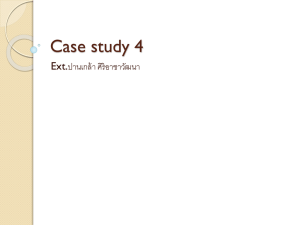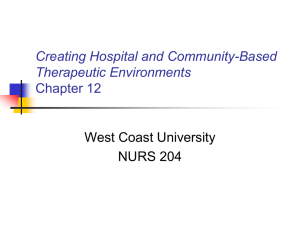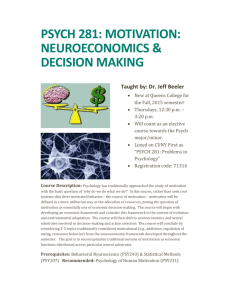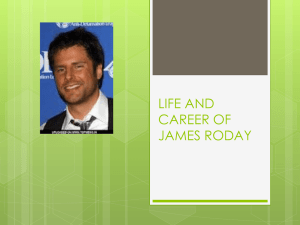psych notes 8
advertisement
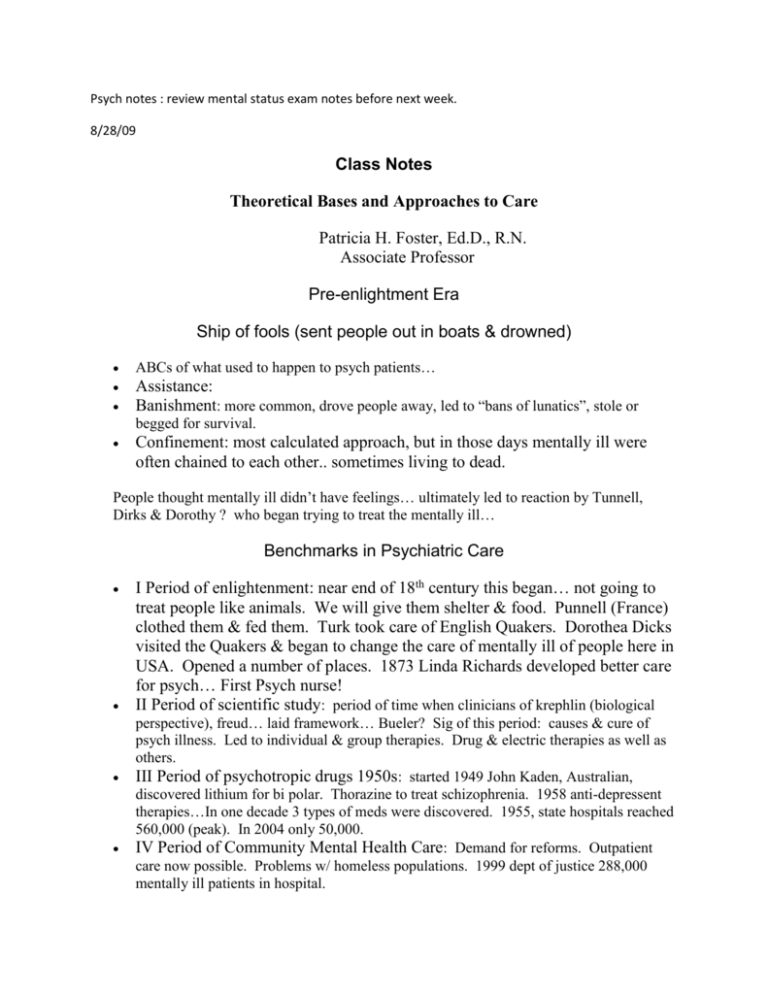
Psych notes : review mental status exam notes before next week. 8/28/09 Class Notes Theoretical Bases and Approaches to Care Patricia H. Foster, Ed.D., R.N. Associate Professor Pre-enlightment Era Ship of fools (sent people out in boats & drowned) ABCs of what used to happen to psych patients… Assistance: Banishment: more common, drove people away, led to “bans of lunatics”, stole or begged for survival. Confinement: most calculated approach, but in those days mentally ill were often chained to each other.. sometimes living to dead. People thought mentally ill didn’t have feelings… ultimately led to reaction by Tunnell, Dirks & Dorothy ? who began trying to treat the mentally ill… Benchmarks in Psychiatric Care I Period of enlightenment: near end of 18th century this began… not going to treat people like animals. We will give them shelter & food. Punnell (France) clothed them & fed them. Turk took care of English Quakers. Dorothea Dicks visited the Quakers & began to change the care of mentally ill of people here in USA. Opened a number of places. 1873 Linda Richards developed better care for psych… First Psych nurse! II Period of scientific study: period of time when clinicians of krephlin (biological perspective), freud… laid framework… Bueler? Sig of this period: causes & cure of psych illness. Led to individual & group therapies. Drug & electric therapies as well as others. III Period of psychotropic drugs 1950s: started 1949 John Kaden, Australian, discovered lithium for bi polar. Thorazine to treat schizophrenia. 1958 anti-depressent therapies…In one decade 3 types of meds were discovered. 1955, state hospitals reached 560,000 (peak). In 2004 only 50,000. IV Period of Community Mental Health Care: Demand for reforms. Outpatient care now possible. Problems w/ homeless populations. 1999 dept of justice 288,000 mentally ill patients in hospital. Community Mental Health Centers Act 1963 1. Community Mental Health Centers diagnosis treatment rehabilitation 2. Crisis Intervention: when a person is in crisis they need action right now… need help w/ anxiety & coping & look for situational support. Need access. o easy access 3. Coordination with Networks: 4. Special Populations elderly children Financing: will the funds continue w/ bad economic time. Federal Action Steps to Promote Systems Integration 1. Access Initiative 2. Improve Outreach & Access to Existing Programs 3. Expand Housing Options & Alternative Services 4. Generate & Disseminate Knowledge and Information 5. Research and evaluation Psychiatric Nursing 1873 Linda Richards graduated from New England Hospital for Women & Children: first psych nurse, need to deal w/ emotional needs of patients First American psychiatric nurse emphasis on physical & emotional needs Somatic therapies insulin shock 1935: not used any more psychotherapy 1936 electroconvulsive therapy 1937: can be done inpatient and/or outpatient now. Sometimes pts complain about short term memory loss. John Hopkins was first school that had psych nursing. Developments in Psychiatry Dr. Hildegard Peplau (1952) Interpersonal Relations in Nursing : talked about the power of interactions of nurses w/ their patients. Maxwell Jones (1953) The Therapeutic Community: A New Treatment Method in Psychiatry : he thought that when a person was in the hospital that setting should be like out in the world. Patients had to vote on things w/in the hospital. Criteria for Abnormal Behavior Subjective Distress: Social Deviance: alcoholism, hearing & responding to voices Psychological Handicap: can’t function & take care of responsibilities, someone w/ OCD that has so many rituals that they can’t function (bathing over & over & over). Psychoanalytical Model Sigmund Freud Id (basic instincts), Ego, Superego (conscience) Anxiety = motivator according to Freud. All behavior is meaningful o Conscious o Unconscious o Preconscious Psychoanalytic Process (maybe chapter 3) Free association : Freud did this… Resistance Dream analysis Interpretation Transference Interpersonal (relationships) Model Harry Stack Sullivan, Hildegard E. Peplau : felt that empathic comm. Is VERY important. Empathic communication (empathy… feels w/ the person) Develop self esteem Basic drives for security Develop satisfactory relationships : Social Model Thomas Szaz (people are to blame for mental illness) & Gerlad Caplan o Primary (things we do to help people such as teaching people how to be parents by doing parenting classes… classes to take in terms of o preparation), secondary (acute care, often seen today in hospitals) tertiary prevention (rehabilitation) crisis intervention (sometimes called primary, sometimes secondary intervention) Patient = consumer Therapist= active community member Existential Model Ellis, Frankl, Glaser, Perls, Rogers, Frankl wrote book called “will to meaning” was in nazi concentration camp , delt w/ the power a person has to deal w/ what comes their way & help them to survive. Authentic self awareness free choice Existential encounter Behavior Therapy : Wolpe, Skinner Behavior model seen a lot w/ discipline & kids, Behavior = conditioned response Without behavioral change = failure Reciprocal inhibition Assertiveness Aversion therapy Token economy : rewards for certain behaviors Operant Conditioning Positive reinforcement Negative reinforcement Combination of + and Extinction Punishment Deconditioning Methods Assertive behavior Desensitization (can be used for someone that has a phobia of something… crossing a bridge, getting on an elevator) Evoke strong anxiety Operant conditioning Medical Model See a lot of this now Treat the ill : Avoids the blame (stigma) : Psychiatric Nurse ANA 1. Therapeutic milieu (environment); 2. Here and now 3. Surrogate parent 4. Care for somatic problems (also do physical assessment, not just psych issues) 5. Teach (about psychotropic meds). 6. Act as a social agent 7. Leadership 8. Psychotherapy 9. Social and community action Goals of the Nursing Interview Establish a trusting relationship Elicit pertinent information Assess verbal & non-verbal behavior Facilitate education of the client Causes of Distorted Messages Personal Factors: Emotional Physical Intellectual Social Environmental Factors physical social Skills to Facilitate Communication Self-disclosure : can give info about being nursing student… not much more. Silence : can be very therapeutic… allows pt to collect thoughts. Touch Mental Status Examination General Description Appearance Speech Motor Activity Interaction during interview Emotional State Mood (self reporting… “what kind of mood are you in?” Affect (emotional tone that we perceive) Experiences Perceptions (any hallucinations or illusions) Thinking Thought content (delusions) Thought process (flight of ideas, never answers question) o We will be charting about these things Sensorium and Cognition Level of consciousness Memory Level of concentration & calculation Information and intelligence Judgment Insight Criteria of Mental Health Positive attitude toward self Growth, development & self actualization Integration Autonomy Reality perception Environmental mastery Diagnostic & Statistical Manual of Mental Disorders DSM IV Axis I: Clinical syndromes Axis II: Personality disorders (antisocial, passive aggressive, borderline) Axis III: General medical conditions (hypertension, cardio issues, pain, etc) Axis IV: Psychosocial & environmental problems (stress, lost job) Axis V: Global assessment of functioning (score on scale from 0 to 100), usually in 40s to 30s. They are in appendix of small Townsend book. Discussion Dress Confidentiality Concerns or fears Splitting Class Notes Mental Status Examination General Description Appearance Speech Motor Activity Interaction during interview Emotional State Mood Affect Experiences Perceptions Thinking Thought content Thought process Sensorium and Cognition Level of consciousness Memory Level of concentration & calculation Information and intelligence Judgment Insight JOIMAT : way to remember this… J = Judgment O = Orientation I = Intellectual function M = Memory A = Appearance T = Thought Observations apparent age : often will look must older than stated age, often have been through so much stress manner of dress : up, showered, dressed, (someone has to watch them shave, can’t have razor w/out supervision) cleanliness posture : unusual gait : facial expressions eye contact : is he making eye contact or not? pupil dilation or constriction general state of health and nutrition Speech rate : volume-loud or soft amount-minimal (paucity [no conversation, just yes or no response]), mute, pressured (pushing, fast, rapid & pressured) characteristics-stuttering, slurring of words or unusual accents Motor Activity level= lethargic, tense, restless or agitated type= tics, grimaces, or tremors unusual gestures or mannerisms-compulsions Interaction during the interview hostile, uncooperative, irritable ? guarded, apathetic, defensive, suspicious? seductive? Important to document from the interview. Mood Self report of the emotional state and reflects the patient’s life situation How are you feeling today? Rate mood on a scale of 0-10 Affect The patient’s emotional tone observed by the nurse during the interview range duration intensity appropriateness Terms to describe affect flat (not show much emotion) restricted (not as flat, judgment) blunted ( labile (changes rapidly) incongruent with speech content (laughing while talking about the death of a loved one) Perceptions: Hallucinations or Illusions Auditory Visual Tactile Gustatory (taste) Olfactory Hallucination (seeing something not there at all) Illusion (seeing something different than what is really there… a shape in the clouds) Thought content Delusions o religious (think they are Jesus) o somatic (has distorted body issues or think they have an illness) o grandiose (I’m a CEO at the hospital) o paranoid o thought broadcasting (my thoughts are being broadcast) o thought insertion (others are putting thoughts in my head) Thought content descriptors Depersonalization (feeling of unreality… not here… distance from body) Hypochondriasis (all kinds of complaints) Ideas of reference (that Hollywood star is singing to me) Magical thinking Nihilistic ideas-thoughts of nonexistence (I have no heart, it is gone or this world no longer exits) Obsession Phobia Thought process descriptors Circumstantial (person will FINALLY get to the point) Flight of ideas (jumps quickly from one thought to another) Loose associations (very little connection between thoughts) Perseveration (stay on same topic over & over… can’t change subject) Tangential (person goes off on a tangent & never gets to the point) Thought blocking (talking & then just stop & may or may not pick back up) Word salad (doesn’t make any sense at all… just words) Level of consciousness Confused, sedated or stuporous Orientation (oriented X 4 means situation as well as person, place & time) Person Place Time Memory Remote-distant past Recent-past week; past 24 hours 3 words--ask to repeat in 15 minutes Immediate recall-repeat numbers forward or backward within 10 seconds Concentration & calculation Count from 1-20 2x3 or 21+7 serially subtract 7 from 100 "How many nickels are there in $1.35?" Ability to conceptualize & abstract (typically people w/ schizophrenia often are so concrete that they can’t understand abstract concepts) When it rains, it pours. A stitch in time saves nine. A rolling stone gathers no moss. The proof of the pudding is in the eating. People who live in glass houses shouldn’t throw stones. Ability to abstract -- list similarities between objects Bicycle and bus Apple and pear Television and newspaper General knowledge Last five presidents Who is the Mayor? Give the occupation of a well-known person Judgment What would you do if you found a stamped, self addressed envelope on the ground? How would you find your way out of a forest in the daytime? What would you do if you entered your house and smelled gas? If you won $10,000 what would you do with it? Insight Does person accept or deny illness? Does the patient blame the problem on someone else or external factors? What does the patient think the nurse has been told? What does the patient want the staff to do?

